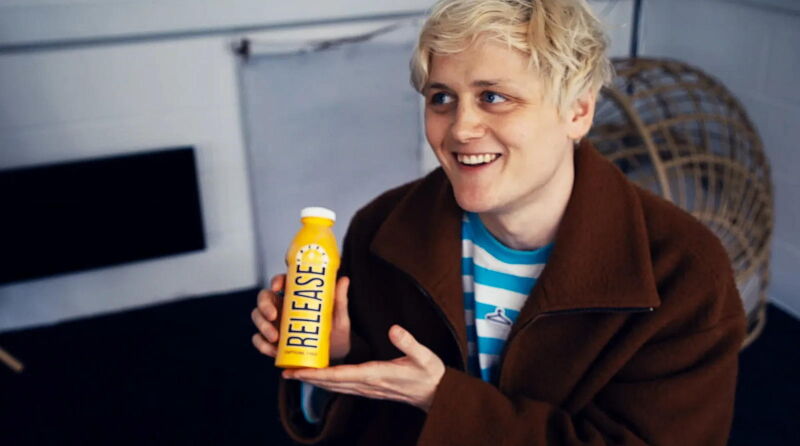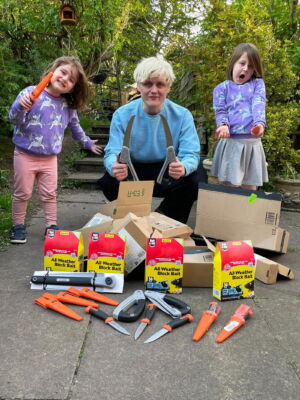
Courtesy of Channel 4
The drink had all the hallmarks of a beverage sensation. Striking design, bold font, and the punchy name Release. But inside, each bottle was filled with urine allegedly discarded by Amazon delivery drivers and collected from plastic bottles by the side of the road.
That didn’t stop Amazon from listing it for sale, though. Release even attained No. 1 bestseller status in the “Bitter Lemon” category. It was created by Oobah Butler for a new documentary, The Great Amazon Heist, which airs on Channel 4 in the UK today.
Butler is a journalist, presenter, and renowned puller of stunts—he’s probably most famous for turning his shed in a London garden into the number one ranked restaurant on Tripadvisor. The Great Amazon Heist begins with him infiltrating an Amazon distribution center in Coventry with a hidden camera and speaking to workers who complain of foot and back pain, potentially dangerous working conditions, and near-constant surveillance. Butler spends his first day unloading a baking-hot truck with no working fan or air conditioning.
Amazon spokesperson James Drummond says “nothing is more important” than employee safety and well-being and that the company provides protective clothing and footwear and has “dedicated health and safety teams on site.”
Butler happens to be present during a hiring spree at the Coventry warehouse. At the time, workers were trying to gain union recognition, and the GMB union has since accused Amazon of deliberately hiring hundreds of extra staff to scupper the vote. Amazon denies this.
He is recognized within days and so resorts to interviewing delivery drivers, who tell him that they’re penalized for slow deliveries to the extent that they have to urinate in bottles because they don’t have time to find anywhere to stop for bathroom breaks.
Drivers urinating in bottles has been reported in the past, but what wasn’t known is that some claim they also get penalized for having those urine-filled bottles in their truck when they return to the warehouse. (Drummond denies this and says Amazon drivers receive reminders to take regular breaks on the Amazon Delivery app). To avoid penalties, they end up discarding the bottles by the side of the road. Butler searches the roadsides near Amazon warehouses from Coventry to New York to Los Angeles and more often than not strikes liquid gold.
From there, it’s laughably straightforward for Butler to get Release listed for sale on Amazon, with very few checks and balances in place to ensure the product he’s selling is safe and legal. “Releasing the drink was surprisingly easy,” Butler told WIRED. “I thought that the food and drinks licensing would stop me from listing it, so I started it out in this Refillable Pump Dispenser category. Then the algorithm moved it into drinks.”
At one point, he’s even contacted by an Amazon representative ready to handle the packaging, shipping, and logistics through the Fulfillment by Amazon program. (No members of the public were actually sent driver urine; instead Butler corralled a group of friends into making the purchases.) When he saw the product listed for sale, Butler felt “initially really excited and found it very funny,” he says. “Then when real people started trying to buy the product, I felt a bit scared.”
Courtesy of Channel 4
Drummond says this was a “crude stunt” and that the company has “industry-leading tools to prevent genuinely unsafe products being listed.”
If there’s a theme to the documentary, it’s that it’s remarkably simple to outwit one of the world’s biggest companies. For his next trick, Butler gets his nieces—aged 4 and 6—to purchase products that are only intended to be sold to adults. In at least four cases, legally required age verification measures were not in place at either the point of sale or delivery. By placing orders with voice control through Alexa, the girls were able to order knives, saws, and rat poison to their front door. Some of these packages were delivered to Amazon lockers, making it physically impossible for the delivery driver to check whether the person receiving the item was an adult.
“Customers must be 18 and over to use Amazon services unless a parent or guardian is involved,” says Drummond. “The majority of products purchased by Channel 4 do not legally require age verification, either at the point of purchase or delivery. Four products were categorized incorrectly, and we have now addressed this.” He says Amazon takes its age verification responsibility “extremely seriously” and that it uses trusted global ID verification systems for bladed items and verifies age on delivery.
The final part of the program turns its attention to Amazon’s taxes—the company has been criticized for using complex but legal arrangements to reduce its overall tax liability, such as running sales through a subsidiary in Luxembourg. Butler interviews Labour MP Nadia Whittome, who argues that Amazon benefits from public infrastructure and should therefore pay its fair share to fix Britain’s crumbling roads. Butler buys pothole filler on Amazon. Knowing that Amazon processes returns based on the weight of the incoming packages, he sends back buckets of sand to get his money back—attempting to shield himself from legal liability for fraud by running everything through a shell company in Belize.
The Great Amazon Heist doesn’t tell us anything particularly new. (Drummond says the documentary is a “heavily distorted picture of our processes and operations that do not reflect the realities of shopping with or working for Amazon.”) But placing all of these elements alongside each other in an hour of television paints a stark picture. Drivers and warehouse workers put up with the conditions because they have no choice. Dangerous products were listed and sold to children with no checks in place. Byzantine structures shield the company from local authorities. According to Amazon’s mission statement, it “strives to be Earth’s most customer-centric company, Earth’s best employer, and Earth’s safest place to work.” The Great Amazon Heist portrays a company that simply doesn’t seem to care.
This story originally appeared on wired.com.

